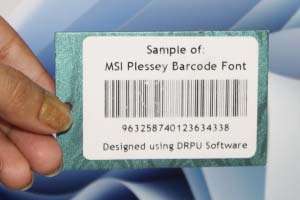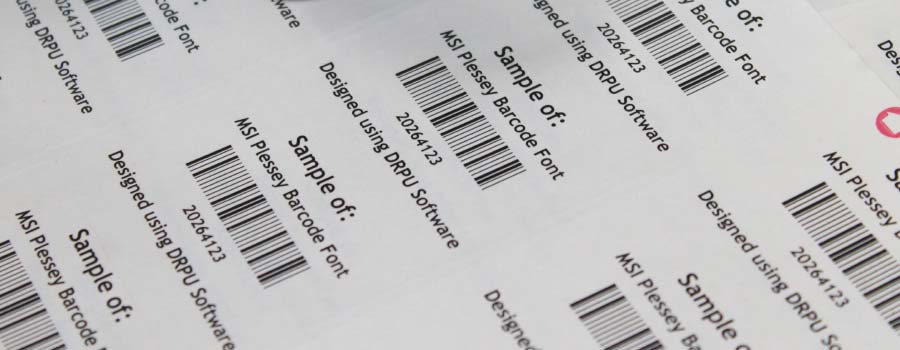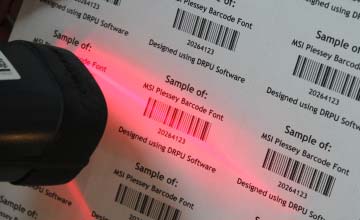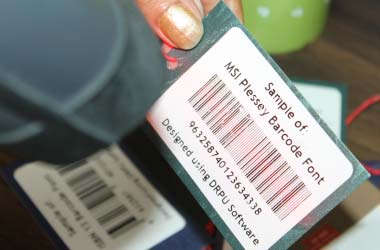The MSI Plessey barcode is similar to other linear barcodes such as Code 39 and Code 128. It is a continuous, variable length symbology that can encode a variety of characters including digits, uppercase letters, and several special characters. It is a one-dimensional barcode that is composed of alternating black and white bars of varying widths. The barcode also contains a start and stop character to indicate the beginning and end of the barcode. The number of bars in the barcode varies depending on the number of characters being encoded, which makes it a variable length symbology.
The structure of an MSI Plessey barcode consists of several elements that define the encoding of the data. These elements include the start character, data characters, check character, and stop character.
-

-
Start Character:
The MSI Plessey barcode starts with a unique start character that is used to identify the beginning of the barcode. The start character in an MSI Plessey barcode is represented by a single bar followed by a single space. The start character is followed by the data characters that encode the information being stored in the barcode.
-
Data Characters:
The data characters in an MSI Plessey barcode can represent digits, uppercase letters, and several special characters. The number of data characters in the barcode can vary depending on the length of the information being encoded. Each character is represented by a series of bars and spaces of varying widths.
-
Check Character:
The check character in an MSI Plessey barcode is used to ensure the accuracy of the data being encoded. The check character is calculated based on the values of the data characters and is added to the end of the barcode. The check character is represented by a single bar followed by a single space.
-
Stop Character:
The stop character in an MSI Plessey barcode is used to indicate the end of the barcode. The stop character is represented by a single bar followed by two spaces. The stop character is added to the end of the barcode after the check character.
The MSI Plessey barcode has several advantages that make it suitable for inventory and stock management applications.
-
➤ Variable Length:
One of the main advantages of the MSI Plessey barcode is its variable length. The number of bars in the barcode can vary depending on the length of the information being encoded. This makes the barcode more flexible and allows it to encode different types of information.
-
➤ High Density:
The MSI Plessey barcode can be printed at high densities, which allows it to encode a large amount of information in a relatively small space. This is particularly useful in applications where space is limited, such as on small products or in cramped storage areas.
-
➤ Easy to Generate:
The MSI Plessey barcode is easy to generate using standard barcode software. This makes it a cost-effective solution for small businesses and organizations that do not have specialized barcode printing equipment.
-
➤ Accurate:
The check character in the MSI Plessey barcode ensures the accuracy of the encoded data. This helps to reduce errors and improves the efficiency of inventory and stock management systems.
Despite its advantages, the MSI Plessey barcode has several limitations that should be considered when choosing a barcode solution.
-
Limited Data Capacity:
The variable length of the MSI Plessey barcode means that it has a limited data capacity compared to other barcode types such as Code 128 or QR codes.
Applications of MSI Plessey Barcode
The MSI Plessey barcode is a continuous, self-checking barcode symbology that is widely used in a variety of applications. Here are some of the most common applications of MSI Plessey barcodes:

-
Inventory Management:
MSI Plessey barcodes are commonly used in inventory management to track the movement of goods within a warehouse or distribution center. Each item is assigned a unique barcode, which is scanned when it is received, stored, and shipped, allowing for real-time tracking of inventory levels.
-
Package Tracking:
MSI Plessey barcodes are also used in package tracking systems, where they are affixed to packages and scanned at various points along the delivery route. This allows for accurate tracking of packages, and helps to ensure that they are delivered to the correct destination.
-
Retail:
MSI Plessey barcodes are commonly used in retail environments to track merchandise, manage inventory levels, and facilitate the checkout process. Each item is assigned a unique barcode, which is scanned at the point of sale, allowing for quick and accurate pricing and inventory tracking.
-
Healthcare:
MSI Plessey barcodes are used in the healthcare industry to track patient information, medication, and medical supplies. They are commonly used on patient wristbands and medication labels, allowing for quick and accurate identification and tracking of patients and their treatment.
-
Manufacturing:
MSI Plessey barcodes are used in manufacturing to track the movement of parts and raw materials, as well as finished products. Each item is assigned a unique barcode, which is scanned at various points along the production line, allowing for real-time tracking of inventory levels and production progress.
-
Shipping and Logistics:
MSI Plessey barcodes are commonly used in shipping and logistics to track the movement of goods and packages. Each package is assigned a unique barcode, which is scanned at various points along the delivery route, allowing for real-time tracking of package location and delivery status.
-
Library Management:
MSI Plessey barcodes are used in library management systems to track books and other library materials. Each item is assigned a unique barcode, which is scanned when it is checked in or out, allowing for real-time tracking of inventory levels and book circulation.
In summary, MSI Plessey barcodes are widely used in a variety of applications, including inventory management, package tracking, retail, healthcare, manufacturing, shipping and logistics, and library management. Their ability to provide real-time tracking and accurate identification of items makes them an essential tool for businesses and organizations looking to streamline their operations and improve efficiency.
Download and Install Barcode Software
Difference of MSI Plessey Barcode from other Barcode Types
MSI Plessey barcode is a type of continuous, self-checking barcode that is different from other barcode types in several ways. Some of the major key differences are described below:
-
Barcode Structure
MSI Plessey barcodes are a continuous, variable-length barcode symbology, meaning that the number of characters can vary depending on the data being encoded. This is different from fixed-length barcodes like UPC and EAN, which have a set number of characters. The barcode structure consists of alternating bars and spaces that represent each character.
-
Character Set
MSI Plessey barcodes can encode only numeric digits (0-9), whereas other barcode types like Code 128 and QR code can encode a wider range of characters, including letters, numbers, symbols, and special characters. This limits the amount of information that can be encoded in an MSI Plessey barcode, but also makes it more efficient and easier to read and scan.
-
Self-Checking
MSI Plessey barcodes are designed to be self-checking, meaning that they contain built-in redundancy to help detect and correct data errors. This is different from other barcode types like Code 39, which rely on an external checksum digit to verify data accuracy.
-
Readability
MSI Plessey barcodes are generally more difficult to read than other barcode types, due to their narrow bar width and lack of quiet zones. They require a higher level of precision in both barcode printing and scanning, which can be a challenge for some applications.
-
Application
MSI Plessey barcodes are commonly used in applications that require high-density barcoding, such as inventory management and package tracking. They are also used in applications that require a self-checking barcode, such as retail and healthcare.
In summary, MSI Plessey barcode is different from other barcode types in its variable-length structure, limited character set, self-checking design, and high-density application. These differences make MSI Plessey barcode well-suited for certain types of applications, but may limit its use in others.
Cost of Implementing MSI Plessey Barcode

The cost of implementing MSI Plessey barcode can vary depending on a number of factors, including the size of the organization, the number of products that need to be labeled, the type of labeling equipment required, and the level of automation needed. The cost of implementing the MSI Plessey barcode can vary depending on a number of factors, including equipment required, and the level of automation needed.
While some of the costs associated with implementing MSI Plessey barcode can be significant, the benefits of barcode labeling, such as improved inventory control and tracking, can outweigh the initial costs over time. Organizations should carefully consider their requirements and budget when evaluating the cost of implementing MSI Plessey barcode. In this article, we will discuss the different costs associated with implementing MSI Plessey barcode.
-
Barcode Label Design Software
To create MSI Plessey barcodes, organizations need to purchase barcode label design software. This software allows users to design and print barcodes on a variety of label types, including adhesive labels, tags, and receipts. Barcode label design software can cost anywhere from $100 to $1,000 or more, depending on the features and capabilities required.
-
Barcode Label Printing Equipment
Organizations also need to purchase barcode label printing equipment to produce MSI Plessey barcode labels. The cost of a barcode label printer can range from $200 for a basic desktop model to $5,000 or more for an industrial printer. In addition to the printer itself, organizations may need to purchase additional accessories, such as label rewinders and applicators, which can add to the overall cost of implementation.
-
Label Stock and Ribbons
Organizations also need to purchase label stock and ribbons to print MSI Plessey barcode labels. The cost of label stock and ribbons can vary depending on the type and size of label required, as well as the quantity needed. For example, a roll of 1,000 2x1-inch adhesive labels can cost anywhere from $20 to $50 or more, depending on the vendor and quality of the label stock.
-
Barcode Verification Equipment
To ensure the accuracy and quality of MSI Plessey barcodes, organizations may need to purchase barcode verification equipment. Barcode verifiers scan and analyze barcodes to ensure they meet industry standards and are readable by scanning devices. The cost of a barcode verifier can range from $500 to $2,000 or more, depending on the features and capabilities required.
-
Labor Costs
Organizations may need to hire additional personnel to design, print, and apply MSI Plessey barcode labels. Labor costs can include the salaries or wages of employees, as well as any additional benefits and training required. The cost of labor can vary depending on the size of the organization and the number of labels that need to be produced.
-
Maintenance and Support
Organizations also need to factor in the cost of maintenance and support for their barcode labeling equipment. This includes the cost of any repairs or maintenance required for printers and other equipment, as well as technical support services. The cost of maintenance and support can vary depending on the vendor and level of service required.
-
Training and Implementation
Organizations may also need to invest in training and implementation services to ensure their employees are properly trained on how to design, print, and apply MSI Plessey barcode labels. The cost of training and implementation services can vary depending on the vendor and level of training required.
